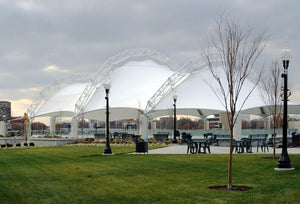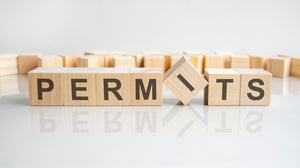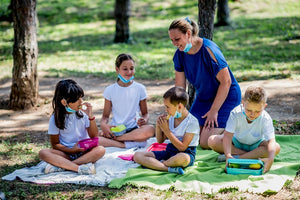Since the beginning of the pandemic, Covid-19 has changed nearly every aspect of our lives. Working from home became a necessity for many who were fortunate enough to do so. Perhaps the biggest impact was on children whose school routines were completely turned upside down. Teachers suddenly had to pivot and create lesson plans that would work for remote learning.
Even though vaccines are now available for school aged children, parents and school administrators are still wary of the ongoing pandemic. That’s why outdoor classrooms have become an emerging trend as a safer alternative to the traditional indoor setting.
Pros of Outdoor Classrooms

Do you remember being stuck in a stuffy classroom, gazing wistfully out the window wishing you could be outside? It turns out that kids have had the right instinct all along. Studies are proving that students actually do better with outdoor learning.
A 2018 study, compared two groups of third-grade students. One group studied biology in an outdoor setting and the other in a regular classroom. The results showed that outdoor learning students had improved focus than those who stayed indoors. Researchers are also finding that outdoor learning includes benefits such as:
- Increased attention span
- Better impulse control
- Reduced stress
- Improved immune function
- Greater engagement with studies
Studies have also shown that students who learn in an outdoor environment are more motivated and retain information better than those who are trapped indoors. Plus, outdoor learners are just plain happier - which makes the challenging job of teaching that much easier.
Ideas for the Outdoor Classroom
1. Get the Whiteboards Ready
Clearly, nature classrooms have outstanding benefits for both students and teachers. And it doesn’t have to deviate too far from indoor learning. To begin creating an outdoor classroom, start with whiteboards. Since outdoor classroom design is quite different from the traditional classroom, you’ll need to think about portability. Fortunately, whiteboards come in both easel and portable designs. Choose a double sided, magnetic dry erase board for added functionality. You can also find larger size whiteboards that can do double duty as a partition to separate learning spaces. Be sure to choose a whiteboard made with durable materials that can withstand daily use.
2. Plan the Seating

Covid-19 isn’t going away any time soon, which means that the practice of social distancing will be with us for some time. Experts say it’s one of the most effective ways to prevent the spread of disease and infection which is why building an outdoor classroom is not only conducive to improved learning, but to safety as well. Opt for single seating versus bench seating and be sure to space students at least six feet apart from each other. Be sure to choose seating works with the work surface students will be using. Seats should be sturdy enough to withstand humidity or moisture.
3. Take Care of the Shade
While outdoor classroom activities have clear advantages, UV exposure is not one of them. It’s hard for students to read anything, let alone pay attention to the teacher with the sun glaring in their eyes. That’s why every outdoor classroom needs a durable tent. It will not only protect the students from the sun’s harmful rays, it will also help keep them cool in warmer temperatures and protect them from rain. Choose a sturdy tent that is like a frame tent or pole tent that will give students plenty of room to social distance while learning in a comfortable environment. It is important to do your research when thinking about what material will best suit your tent needs. Be sure to pay close attention to quality so that your outdoor classroom tent will last for years to come.
4. Put the Tables Out
Just like when they study indoors, students will need a sturdy and practical work surface in their outdoor classroom. Due to COVID and social distancing recommendations, multiple students should not be crowded around a single table. Be sure to choose designs that are made for individual students, ergonomically correct, and provide ample space for students to spread out materials. The work surfaces should also be made to withstand fluctuating temperatures and humidity levels. Equip each student’s table or desk with hand sanitizer. Also, choose tables that are multifunctional and can also be used for eating lunch or working on larger projects.
5. Plant Some Green

For teachers, planning outdoor classroom ideas can actually add a great deal of value to their lesson plans. What better environment to learn about biology than in an outdoor setting? From clouds and plants to insects and animals, students have a wonderful opportunity to experience nature firsthand. Planting a garden is an outdoor activity that is both fun and educational. Whether it’s a vegetable garden or a butterfly flower garden, students will learn important lessons about horticulture that will last them a lifetime. If the space allows, planting trees is another excellent outdoor activity that is also good for the environment.
6. Put On the Walls or the Fence
No one wants to sit in a wet or drafty classroom. Make sure students stay warm and dry by installing sidewalls. When you add sidewalls, it’s much easier to regulate your outdoor classroom’s temperature. In chilly weather, sidewalls can help keep the indoor temperature warmer. Choose a sidewall with windows so students can still take advantage of the benefits of being outdoors. They still provide protection from inclement weather, but students can still see outside and will barely know they are there. Adding sidewalls to your classroom tent can help extend the amount of time that you can safely and comfortably learn in an outdoor setting.
In Conclusion
Living in a post-pandemic world definitely requires us to be more flexible in most aspects of our lives. The pandemic taught us many lessons, some of which are very important. Many of us learned that we can work effectively from home and that children are much more adaptable than many of us ever realized. The benefits of outdoor learning are one of the better lessons that we’ve learned. With proper planning, an outdoor classroom can be an effective learning environment for students of all ages. In addition to improved focus on lessons, students reap huge benefits for their overall emotional well-being.
Choosing the right materials, from whiteboards to tables and chairs, is essential for a successful outdoor classroom. Our team is here to advise you on how to choose the best tent for your classroom needs. Contact us today for help with everything from planning and installation to maintenance.











